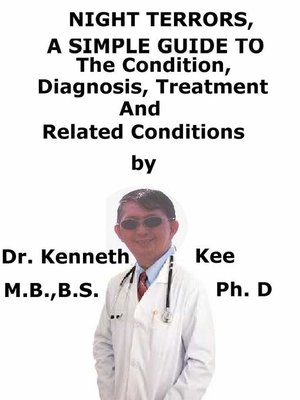Night Terrors, a Simple Guide to the Condition, Diagnosis, Treatment and Related Conditions
ebook
By Kenneth Kee

Sign up to save your library
With an OverDrive account, you can save your favorite libraries for at-a-glance information about availability. Find out more about OverDrive accounts.
Find this title in Libby, the library reading app by OverDrive.



Search for a digital library with this title
Title found at these libraries:
| Loading... |
This book describes Night Terrors, Diagnosis and Treatment and Related Diseases
When I was a young boy I used to be wakened up by my brothers who said that I was disturbing their sleep by thrashing and screaming in my sleep.
Mind you they were not concerned about me but about the fact that I was disturbing their sleep.
I did not remember what happened in my sleep.
May be it happened only after a high fever when I was stung by a jellyfish or it could be due to the concussion that occurred after a fall while climbing a high tree.
After a few months my night terror problem probably stopped because my brothers did not wake me up during my sleep.
Night terrors (also called sleep terrors) are a sleep disorder in which a person quickly wakes from sleep in a terrified state.
Night terrors are events of intense screaming, crying, thrashing, or fear during sleep that happen again and again, normally in children ages 3 to 12.
Night terrors happen during non-REM sleep, normally about 90 minutes after a child falls asleep.
Night terrors tend likely to run in families.
Causes
Night terror is a sleep disorder producing feelings of panic or dread normally happening during the first hours of stage 3–4 non-rapid eye movement (NREM) sleep and persisting for 1 to 10 minutes.
Night terrors normally start in childhood and normally diminish with age.
Risk factors which may cause night terrors are:
1. Young age,
2. Sleep deprivation,
3. Medicines,
4. Stress,
5. Fever, and
6. Intrinsic sleep disorders.
While the frequency and severity vary between different persons, the incidents can happen in intervals of days or weeks but can also happen over successive nights or many times in one night.
Night terrors are likely to happen during periods of arousal from delta sleep.
Delta sleep (called slow-wave sleep) happens most often during the first half of a sleep cycle, which suggests that people with more delta-sleep activity are more susceptible to night terrors.
They can also happen during daytime naps.
They can persist longer, particularly in children.
The precise cause is not known, but night terrors may be activated by:
1. Fever
2. Lack of sleep
3. Periods of emotional tension, stress, or conflict
They can happen in adults, particularly when there is emotional tension or alcohol use.
Most of the time, they have no definite cause.
But certain things might have a part, such as:
1. Stress
2. Depression or anxiety
3. Fever
4. Too much caffeine
5. Sleeping in a different place or away from home
6. Lack of sleep
7. Medicines that affect the central nervous system (the brain)
8. Restless legs syndrome
9. Sleep disorders like sleep apnea
10. Recent anesthesia for surgery
Symptoms
Night terrors are most frequent during the first third of the night often between midnight and 2 a.m.
During a night terror episode, a child might:
1. Sit up in bed
2. Flail around in bed
3. Scream
4. Look awake but be confused
5. Seem like they don't know that a parent is there
6. Not talk
7. Not respond when a parent comforts them
8. Most episodes last only a few minutes, but it may take up to 30 minutes before the child relaxes and goes back to sleep.
They often have no memory of the incident when they wake up the next day
Night terrors are not dangerous, but they can disrupt the child's sleep.
In many cases, a child who has a night terror only requires to be comforted.
In most children, night terrors ultimately subside and do...






